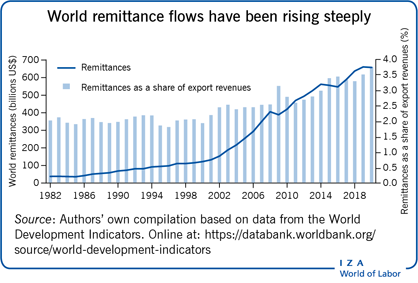Elevator pitch
Remittances have risen spectacularly in absolute terms and in relation to traditional sources of foreign exchange, such as export revenues. Remittances can improve the well-being of family members left behind and boost growth rates of receiving economies. They can also create a culture of dependency, lowering labor force participation in recipient nations, promoting conspicuous consumption, and accelerating environmental degradation. A more thorough understanding of their impacts can help formulate policies that enable developing economies to harness the most out of these monetary inflows.

Key findings
Pros
Remittances can increase the well-being of receiving households by smoothing consumption and improving living conditions.
Remittances can facilitate the accumulation of human capital, promoting healthier life styles, access to healthcare, and greater educational attainment.
Remittances can ease the credit constraints of unbanked households in poor rural areas, facilitate asset accumulation and business investments, promote financial literacy, and reduce poverty.
Cons
Remittances can reduce labor supply and create a culture of dependency that inhibits economic growth and raises inequality.
Remittances can increase the consumption of non-tradable goods, raise their prices, appreciate the real exchange rate, and decrease exports, thus damaging the remittance-receiving country’s competitiveness in world markets.
Remittances can have negative impacts on the environment and promote some types of criminal activity.